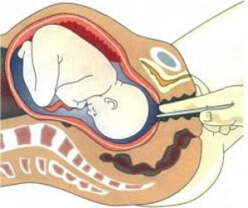Galactorrhea
 A galactorrhea is an abnormal secretion of milk or colostrum by the mammary glands. This process is more often bilateral and has nothing to do with childbirth and lactation. Galactorrhea is diagnosed in 1 to 4% of women, 33% of whom have at least one birth. Low morbidity, most likely, can be explained by the fact that the galactorrhea sometimes has a transient( short-term) character and / or does not cause serious inconvenience to women, especially if the nasal discharge does not have an independent character.
A galactorrhea is an abnormal secretion of milk or colostrum by the mammary glands. This process is more often bilateral and has nothing to do with childbirth and lactation. Galactorrhea is diagnosed in 1 to 4% of women, 33% of whom have at least one birth. Low morbidity, most likely, can be explained by the fact that the galactorrhea sometimes has a transient( short-term) character and / or does not cause serious inconvenience to women, especially if the nasal discharge does not have an independent character.
The physiological formation of milk in the mammary glands is called lactation. Milk is formed in the glandular structures of the mammary gland and is regulated by a whole group of hormones:
• Growth growth hormone;
• Thyroxine is the thyroid hormone;
• Cortisol formed in the adrenal glands;
• Pancreatic hormone - insulin;
• Ovarian estrogens;
• And finally, the most "influential" in the process of milk secretion is the hormone prolactin. It is synthesized by the pituitary cells in a cyclic mode and accompanies all the most important periods of a woman's life - menstruation, pregnancy, lactation and aging. The level of prolactin in the blood plasma changes as it grows up: in newborns it is similar to the maternal( ie, high) and begins to decrease smoothly until puberty, after which it reaches the normal values inherent in adult women. With the onset of menopause, the amount of prolactin decreases in proportion to the decrease in estrogen.
The content of prolactin grows from the first days of pregnancy and becomes the maximum on the eve of childbirth, during this period the future mother has the first milk-like discharge from the breast - colostrum. Breastfeeding stimulates the production of prolactin. After the end of feeding, the values of prolactin return to normal values.
Galactorrhea in pregnant and lactating women has the character of physiological lactation. Pathological galactorrhea is considered if it occurs in a non-pregnant woman, or if it does not disappear one year after the end of breastfeeding.
The high content of prolactin in the blood leads to the appearance of galactorrhea, but it is by no means always its sole cause.
The galactorrhea is not an independent disease and states the condition of the mammary glands. In some women, the diagnosis of a galactorrhea is not clinically relevant. However, in some cases, the syndrome of galactorrhea includes a number of other pathological symptoms. Particular attention should be paid to the combination of galactorrhea with violations of the normal menstrual cycle, in 80% of patients there is galactorrhea and amenorrhea or galactorrhea and oligomenorrhea.
Galactorrhea, not related to pregnancy and lactation, has a very wide range of causes and requires detailed diagnosis.
Causes of galactorrhea
Not every woman can figure out the cause of the galactorrhea. If at the examination of patients the cause of hypersecretion of the mammary glands is not established, they speak of an idiopathic( functional) galactorrhea. Most likely, the presence of galactorrhea in such patients is associated with increased sensitivity of the mammary glands to prolactin, even if its normal content in the blood.
The nature of the secretions from the mammary glands and their number is not related to the cause of their appearance.
The process of milk formation is multistage and difficult, it occurs with the participation of pituitary hormones, ovaries, thyroid and pancreas, is regulated by the central nervous system. Thus, galactorrhea can provoke disorders that have arisen at any stage of this process.
With increasing prolactin levels in 50 - 80% of patients there is a galactorrhea.
The most common causes of galactorrhea include the following:
- Dysfunctions of the pituitary gland or its tumor( more often - prolactinoma);
- Dysfunction of the hypothalamus;
- Some medicines( antihypertensive and antiemetics, antidepressants, tranquilizers), including hormonal contraceptives;
- Thyroid dysfunction( hyperthyroidism and hypothyroidism);
- Adrenal disease;
- Some herbal remedies that are natural estrogens;
- Polycystic ovary syndrome;
- Severe kidney and liver damage;
- Traumatic lesions of the mammary glands( for example, during surgery) or deep chest burns;
- Mastitis( especially its severe forms);
- Excessive mechanical stimulation of the mammary glands, associated with the wearing of tight underwear, skin rash, increased sexual activity and other similar factors;
- Negative impact of stressful situations.
Among the reasons listed above, the most "popular" is prolactinoma of the pituitary gland - a benign hormone-dependent tumor that stimulates excessive production of prolactin.
The frequency of galactorrhea in healthy women varies throughout the life of 2-20% and is not associated with serious pathological causes.
In order to establish the cause of the galactorrhea and determine the need for its treatment, you should visit a specialist.
Symptoms and signs of galactorrhea
The main( and only) sign of galactorrhea is a milk-like discharge from the breast. In appearance, the secret for a galactor is not always exactly like milk and can vary from translucent to milky white. Since the composition of milk includes water and emulsion fat, as well as more than 100 other components, any quantitative deviation in the secretion also changes its appearance. Excretions from the mammary glands should not be sucronic or bloody, this color of the separated indicates serious pathological processes and requires an additional emergency examination.
Most patients point to the bilateral nature of the galactorrhea. Complaints about the allocation of milk from only one breast can indicate both a serious pathological process and be a non-dangerous symptom. Abundant spontaneous discharge from one breast( "dirty linen" and "flow out by themselves") can be caused by a benign tumor of the pituitary gland( prolactinoma), and a small one-sided release of serous secretion is noted in a significant proportion of healthy women giving birth.
The galactorrhea can be permanent and unstable. Spontaneous galactorrhea causes women to turn to a specialist. At the reception, they complain about spontaneous discharge of milk( one or two-way), leaving traces on the underwear and causing irritation of the skin of the mammary glands.
If the galactorrhea is manifested only when pressing on the breast and does not bother the woman, it is very rarely an occasion to contact a doctor and is diagnosed accidentally.
If the galactorrhea is combined with other anxiety symptoms, it becomes a sign of serious impairment in the body. Violations of the menstrual cycle exacerbate the syndrome of galactorrhea and indicate pathological hormonal abnormalities, namely, hyperproduction of prolactin. Sometimes galactorrhea and amenorrhea develop simultaneously. Women with infertility often note the presence of galactorrhea.
Galactorrhea with normal prolactin does not have distinctive clinical features.
A rare and insufficiently studied is the syndrome of primary hypothyroidism( hypothyroidism of the thyroid gland), in which hypothyroidism develops galactorrhea and amenorrhea.
As a monosymptom, the galactorrhea is not clinically significant, but its combination with other disorders( especially hormonal ones) may indicate the presence of serious diseases.
The alarming symptoms accompanying galactorrhea are frequent intense headaches, visual impairment, pathological changes in the menstrual cycle, amenorrhea, or infertility.
Diagnosis of galactorrhea
In order to diagnose a galactorrhea, it is sufficient to conduct a general examination of the patient and to identify the presence of a detachable( one- or two-sided) of the mammary glands. If it does not look like colostrum or milk, it can be confused with the gland ducts opening from the other( non-dairy) ducts opening on the nipple. Therefore, during the inspection, the material is taken( secret glands) for subsequent laboratory testing. With external examination of the mammary glands, traumatic skin lesions( including piercings), irritations or rashes are excluded.
During the conversation with the patient, important diagnostic factors are clarified:
- Circumstances that provoked galactorrhea. Often the discharge from the chest is temporary and pass on their own. A galactorrhea may appear after an abortion or after taking certain medicinal substances. In such cases, the diagnosis of galactorrhea does not require immediate intervention;
- How long secretions from the mammary glands continue, they appear spontaneously or only with manual separation. If the amount and amount of secretion tend to increase, the galactorrhea may be associated with the presence of a serious disease;
- Menstrual irregularities and / or infertility in combination with galactorrhea mean changes in normal hormonal regulation in the patient's body and require additional examination;
- Extragenital diseases. Some endocrine diseases, renal or hepatic insufficiency provoke a galactorrhea;
- Complaints of a patient with a galactorrhea for intense headaches and visual impairment make it possible to suspect the presence of a benign pituitary tumor.
Painful seals in the mammary glands found during palpation( especially if the patient indicates their relationship to the menstrual cycle) suggest the presence of mastopathy.
Often, the diagnosis of galactorrhea is associated with an increase in prolactin levels, 50-80% of patients with elevated prolactin levels in the blood have a galactorrhea. Determining the level of prolactin in the blood is a very important diagnostic criterion. Blood sampling is performed on the 5th-8th day of the cycle.
Prolactin is produced in the body cyclically, its parameters are diurnal fluctuations and depend on some external and internal factors( for example, hypothermia or stress), so galactorea with normal prolactin should not be ignored.
Laboratory diagnostics, in addition to the definition of prolactin, includes determining the level of thyroid hormones( TSH) and sex steroids( FSH, LH and others) in the blood.
Examination of related specialists( including laboratory) in the presence of extragenital pathology is necessary to clarify the nature and cause of the galactorrhea. The findings of the neurologist, endocrinologist and oculist in some cases help clarify the causes of galactorrhea and determine the choice of therapeutic measures.
Instrumental studies for galactorrhea include:
- Mammography and ultrasound of the mammary glands. Identify the presence of mastopathy and / or expansion of the milk ducts;
- Computed tomography( CT) scan of the brain for the diagnosis of benign tumors;
- ultrasound of the pelvic organs. The hormonal origin of galactorrhea confirms the observed structural abnormalities in the ovaries( especially polycystosis).
Treatment of galactorrhea
The galactorrhea has no independent value as a disease and is considered as part of the symptom complex of other diseases. Therefore, the treatment of galactorrhea is to eliminate the causes of its occurrence.
The main directions of therapy are drug reduction of prolactin level and removal of hormonal disorders. To reduce the level of prolactin in the blood used Bromkriptin, Parlodel, Pergolid and their analogues.
In patients with infertility or / and other gynecological diseases, the galactorrhea disappears when hormonal ovarian dysfunction is eliminated.
In rare cases in the presence of a pituitary tumor, the progression of hyperprolactinemia can not be prevented by conservative methods, and surgical intervention is performed.
A galactorrhea against a background of diseases of the thyroid gland or adrenal glands is treated together with endocrinologists. Patients with idiopathic galactorrhea are to be monitored.


